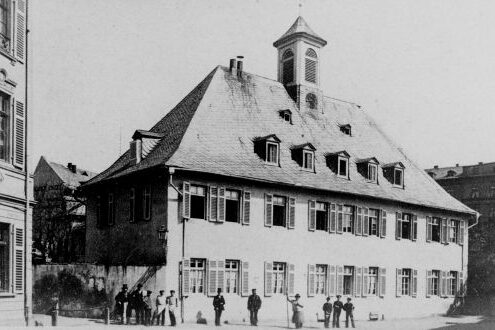Hospital
The old Wiesbaden hospital at Kochbrunnen, founded around the middle of the 14th century, was for a long time the only care facility for the needy and sick. It served as both a monastery and a hospital, and was connected to a bathhouse. After the establishment of the municipal hospitals, the hospital was closed in 1879 and the building demolished.
Around the middle of the 14th century, Count Gerlach I of Nassau-Idstein and Wiesbaden (ca. 1283-1361) and his sons founded a hospital dedicated to the Holy Spirit at Kochbrunnen. For a long time, this facility was the only place of care for the needy and sick. The hospital was not a hospital in the modern sense, but an institution with much broader tasks: It served the care of the poor, the accommodation of old people who could buy their way in here through capital or an annuity contract, and the medical care of people with "disgusting, incurable or infectious ailments". In addition, the so-called mentally ill were housed here; in other words, it was an infirmary, poorhouse and monastery.
The building, which housed a Chapel of Our Lady mentioned since the 15th century, was connected to a bathhouse - later a bath for the poor - connected to the Kochbrunnen spring. In 1573, a special leper house was built and the leper bath was purchased by the hospital in 1584. In the 16th century, the hospital still had considerable income and property, e.g. mills and a brewery, which was leased out. The inmates were then fed from the interest. Since the Thirty Years' War, the hospital was much worse off; at times the hospital administrator sent the inmates out to beg.
The condition of the building repeatedly gave rise to complaints: in 1555, the buildings were in danger of collapsing, and after makeshift repairs in the second half of the 17th century, the house was almost no longer habitable. A new building was erected in 1682, which existed for around 100 years. In 1784, this building also threatened to collapse; shortly afterwards, a larger new building was erected, to which the Prince of Orange, the Elector of Mainz and the City of Frankfurt contributed funds. In return, the hospital had to accommodate a number of "Frankfurt city poor" free of charge. The "house poor" of Wiesbaden also received their alms from the beggars at the hospital on Wednesdays and Sundays.
Next to the hospital was a burial ground, the cemetery for the poor. The hospital was administered by a hospital deputation, which included the town physicist. The "hospital father" examined each inmate for their condition and on the basis of their bathing certificates in order to keep people from wandering around. Some inmates only had the use of the baths and the hostel, others were also given food. The town physicist treated the sick free of charge. In 1787, the institution was entrusted with the care of the poor for the town and the Wiesbaden district. The necessary funds were raised through collections and an annual subsidy from the princely pensioners. Another source of income was the poor people's spinning mill associated with the hospital. In 1801, 359 hospital guests were accommodated during the spa season.
Following the construction of the infantry barracks, all the rooms in the hospital and some of the baths had to be given over to the so-called "military patients" from 1814. This situation lasted until the old dilapidated poor bathhouse was demolished in 1822 and a new building for the military was erected on Dotzheimer Straße in 1828/29.
In 1823/24, building director Carl Florian Goetz built a new, larger bathhouse for what was now known as the Civil Hospital at the corner of Saalgasse, which was extended to the north, and Nerobach, which was joined to the hospital by a two-storey connecting building. From then on, there was room for 200 beds in 50 rooms; separate accommodation for women was set up in the attic.
The hospital building was given a clock tower at this time, which housed the clock from the former school in Sauerland. At this time, four orderlies were employed purely to care for the sick. The treatment of the sick consisted, among other things, of administering baths, drinking cures and cupping. The fact that operations were also performed is shown by the presence of a large number of surgical instruments and an apparatus for inhaling chloroform in 1860. The hospital also had an "anatomical-pathological collection", which Chief Medical Councillor Johann Karl Wilhelm Vogler (1796-1869) recommended in his book on the Wiesbaden springs in 1848/49 to all passing doctors for inspection. In June 1864, the hospital was occupied by 100 patients.
The relocation of the hospital or a new building had been discussed since 1847. In 1865, complaints were made that the hospital did not even meet the most modest contemporary requirements of a public hospital. At that time, the hospital consisted of a residential building, courtyard building, bathhouse, wing and connecting building. After the construction of the municipal hospitals on Schwalbacher Straße, the old hospital was demolished in 1879.
Literature
- Struck, Wolf-Heino
Wiesbaden in the Age of Goethe, Wiesbaden 1979.
- Renkhoff, Otto
Wiesbaden in the Middle Ages. History of the City of Wiesbaden 2, Wiesbaden 1980.
- Spielmann, Christian und Krake, Julius
Historical Atlas of the City of Wiesbaden. Twelve digitized city maps of Wiesbaden 1799 - 1910, edited by Thomas Weichel with the assistance of Rudolf Krämer, Wiesbaden 2002.
